New Boston Historical Society
New Boston, New Hampshire

Todd's Corner
(continued from the previous page)
For each year's collection of articles, we highlight below those of particular interest to historians, with brief quotes from the columns.
Click on links like "2002 collection" to view the corresponding PDF in a new window. Again, the PDF for a given year will contain all the columns for that year, not just those with a historical focus.
We thank Bob and the New Boston Bulletin's editor Brandy Mitroff for permission to reproduce Bob's columns!
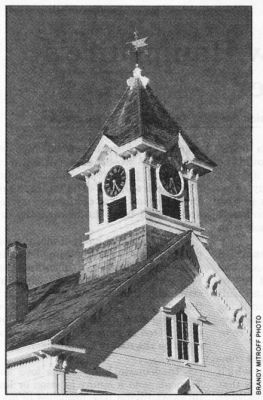 2002 collection
2002 collectionHumble Farm Crafts (2/2002) includes blacksmithing and butchering: I followed Grandpa out to the old blacksmith shop that stood on Todd's Corner next to the farmhouse. Although the building was bowing and leaning, held up mostly by the equipment and the iron and wood scraps left inside at the end of his last regular day there, the old brick forge and bellows still functioned.
Timelessness of Our Town Clock (5/2002) about winding by hand the clock in the 1888 Town Hall: This effort caused him to puff considerably and he commented, "This gives me aerobic exercise, first in climbing the stairs to get to this level, then in turning the crank 25 times to wind the bell and 200 times to wind the clock".
Trees Bear Witness to the Human Experience (6/2002) about trees from the Colonial era: For days I tried to reconcile how the hickory forest could arrive in New Boston since the northern limit of its growth range was a line running westerly from Boston to the Connecticut River. Further, the seed is so heavy that it does not travel far from where the seed drops. Then it came to me: Boston, the home of the first settlers that came to town.
Valley Hall (8/2002) about the upstairs of Dodge's Store: I opened the heavy door with "Valley Hall" painted on the glass, climbed the wide spiral staircase to the second story, passed down the hallway followed by the echo of my footsteps from the solid wainscoting and high ceiling, to the barber shop.
A Legacy of Shoemaking (9/2002): My father told me much about the lives of my ancestors who resided at Todd's Corner, I am fortunate in that regard, and I recall what he told me about his great-grandfather, Samuel Todd, being a shoemaker in addition to being a farmer.
The Cider Press (12/2002) about a mill: To my knowledge, the Belanger's cider press is the only remaining Whipple Farm equipment still functioning as it did 120 years ago.
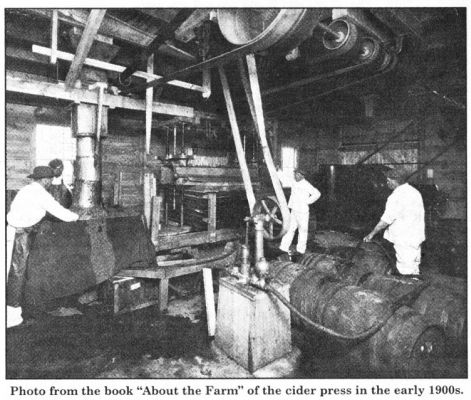
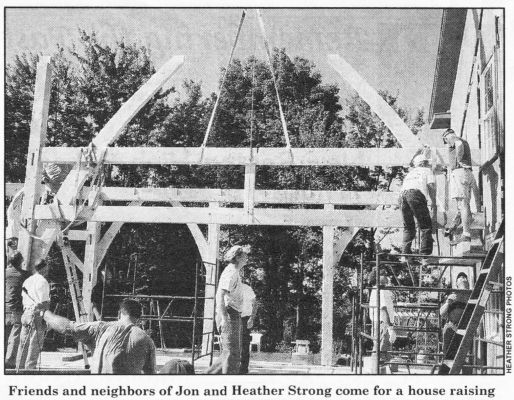
Old Homesteads: Linking Past With Present (9/2003) about a house before it was the Hundred Acres Monastery: The records show that William Langdell and his son, Livermore, moved to the property in 1771. Livermore established the first sawmill and gristmill in this part of New Boston and he apparently prospered while raising twelve children.
Traditional Neighborliness: A House Raising (11/2003) about raising a post & beam house: Near the structure were stacks of braces, long beams, corner posts, and trusses... I saw as many as 18 volunteers work in unison to move one of the long beams.
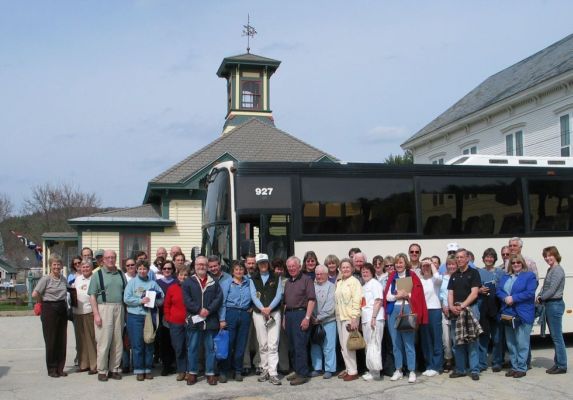 2004 collection
2004 collection
The Significance of Stonewalls (1/2004): During the period 1750 to 1830, about three generations on a human scale, farmers plucked stones from fields and pastures and piled them thigh-high in a network on the landscape of New Boston.
Solving the Mystery of "The Plains" (2/2004) about New Boston's first settlement: The 18th century farm complex has features of high integrity and worthy of protection. In essence, the site has, amazingly, not been disturbed since 1753.
Land-Supported Churches in New Boston (4/2004) about ministry in the early settlement: The inhabitants soon realized that settling the minister on lot 61, three miles from the meetinghouse, was impractical.
Town History From A Bus Window, Parts I-III (5/2004-7/2004) about a historic tour of New Boston, which included mills, churches, old houses, farms, stores, the cemetery, the Bombing Range, Sunday Driver Rock, the river and the railroad depot.
Swinging Down a Swath (9/2004) about scything a field: The best scythe man would go first to set a pace that challenged the others that followed him.
Remembering a Shady Era (11/2004) about elm trees: In 1963, the 200th anniversary of the New Boston charter was celebrated, in part, under the shade of these same great elms while they were showing dead limbs and many "yellow flags", not as festive decoration, but as a sign of doom.
2005 collection
More History from the Attic (3/2005) about the N.H. Militia in the 1800s: The last instruction warned that "Soldiers shall not discharge guns on the morning of inspection... every fouled or dirty gun noted during inspection shall subject its owner to a fine."
Researching Your Old House (9/2005) — an introduction to researching house history.
2006 collection
Our Granite Heritage (1/2006) about surface quarrying granite: Some can still imagine hearing the echo of a stonecutter's hammer tapping the chisels and plugs on the granite hills.
A Day On The Farm: May 26, 1863 (6/2006) imagines a typical day in New Boston almost 150 years ago.
A Cloud Over The Second NH Turnpike (8/2006) about legal disputes between New Boston and the State in the 1800s.
A Legend Revisited (11/2006) about Joe English and Native Americans around 1700: He did not know that he had been spotted by a party of three Abnaki men who were also scouting the area, not for canoes, but for scalps of white men and of the Penacook tribesmen friendly to the whites.
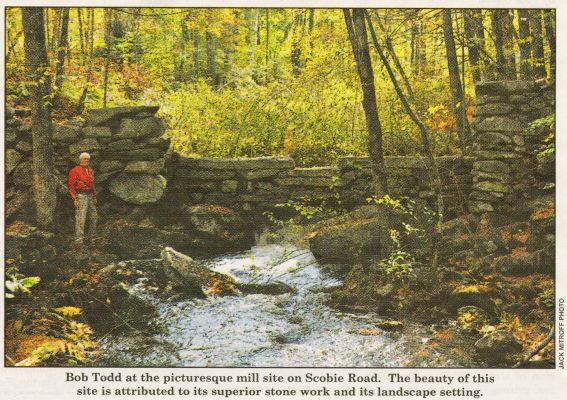 2007 collection
2007 collection
Lamplighter Loses Job (3/2007) about the electrification of New Boston: "The streets and some places of business are lighted by electricity from the plant of Allan P. Wilson, a young man of growing knowledge as an expert in this line, whose business increases."
Flood Waters Destroy History (6/2007) about the water mills of New Boston's Paper Mill Village or Gougeville: I could see the remains of an old mill site, a massive stone construction consisting of an array of walls on the river banks.
P.H. Saltmarsh: Linch-pin of Local Economy (10/2007) about a local entrepreneur in the 1930s-40s: Paul picked up the freight in the morning, then loaded the same trucks with crates containing melons packed tightly with new mown hay and delivered them to Boston markets in the evening, often arriving back in New Boston about midnight.
Getting to Know Great Grandpa (11/2007) about James P. Todd, born 1820: For several years, Issacher, Jr. made an issue of James cultivating his hops so close to the grave site and argued with James about where the boundaries were located.
Weighing Up the Local Trade (12/2007) about scales: Minnie Miller, Herman "Bing" Miller's mother, charged 10 cents to come out and unlock the shelter and operate the scales even though it interrupted her household work.
2008 collection: clippings of Bob's columns for this year are on file in the Historical Society
2009 collection: clippings of Bob's columns for this year are on file in the Historical Society
2010 collection
Grandma's Life Not All Drudgery (9/2010) about life on a New Boston farm in the early 1900s: They took the afternoon train from the depot in downtown New Boston to the Manchester Train Station. After the movies they stayed overnight, presumably at the Carpenter Hotel, and went home on the morning train.
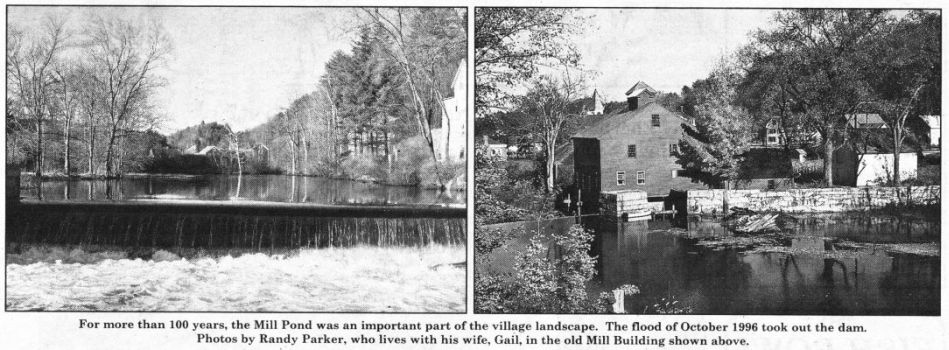
Ice Cakes Warmed Local Economy (3/2011) about ice ponds and ice houses: The Whipple enterprise used large amounts of ice on the farm to hold produce for fresh delivery to the hotels. Several local men were tasked with keeping the farm supplied with ice year round.
Bricks: Building Blocks and Time Markers (10/2011) about brickmaking: The clay was kneaded by hand, or by treading in it with bare feet. I think that is a process which I would have enjoyed as a youngster.
Water Mill Sites on the Piscataquog (11/2011): There have been about 42 additional mills operated on the branches of the Piscataquog river system in New Boston.
2012 collection
The Legacy of District Schools in New Boston (4/2012) about one-room schoolhouses.
Paper Mill Village: Olden Industrial Center (5/2012) about the southwestern corner of New Boston: The Union Paper Mill Company developed the site about 1866 or 1869 to manufacture paper from discarded rags (worn-out underwear and stockings, etc.).
First Families Molded Landscape and Community (6/2012) about New Boston's 18th-century settlers.
2013 collection
New Boston History in the Shade — Parts 1-5 (2/2013-6/2013) describe the role of trees in New Boston history from providing masts for King George's navy to maple syrup production today.
New Boston Was Cradled in the Village on the Hill (8/2013) about the original location of the village center atop Meetinghouse Hill.
2014 collection
List of columns - all articles published 1998-2014.
Return to the previous page for 1998-2001 collections of Bob Todd's articles.
